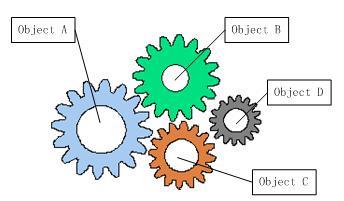Spring框架详解(了解IOC,AOP)
Posted 3 ERROR(s)
tags:
篇首语:本文由小常识网(cha138.com)小编为大家整理,主要介绍了Spring框架详解(了解IOC,AOP)相关的知识,希望对你有一定的参考价值。
一、spring入门
1.理解IOC
- IOC是Inversion of Control的缩写,多数书籍翻译成“控制反转”。
- IOC理论提出的观点大体是这样的:借助于“第三方”实现具有依赖关系的对象之间的解耦。
我们知道在面向对象设计的软件系统中,它的底层都是由N个对象构成的,各个对象之间通过相互合作,最终实现系统地业务逻辑。

大家看到了吧,由于引进了中间位置的“第三方”,也就是IOC容器,使得A、B、C、D这4个对象没有了耦合关系,齿轮之间的传动全部依靠“第三方”了,全部对象的控制权全部上缴给“第三方”IOC容器,所以,IOC容器成了整个系统的关键核心,

把上图中间的IOC容器拿掉,然后再来看看这套系统:我们现在看到的画面,就是我们要实现整个系统所需要完成的全部内容。这时候,A、B、C、D这4个对象之间已经没有了耦合关系,彼此毫无联系,这样的话,当你在实现A的时候,根本无须再去考虑B、C和D了,对象之间的依赖关系已经降低到了最低程度。

软件系统在没有引入IOC容器之前,如图1所示,对象A依赖于对象B,那么对象A在初始化或者运行到某一点的时候,自己必须主动去创建对象B或者使用已经创建的对象B。无论是创建还是使用对象B,控制权都在自己手上。通过前后的对比,我们不难看出来:对象A获得依赖对象B的过程,由主动行为变为了被动行为,控制权颠倒过来了,这就是“控制反转”这个名称的由来。
2.导入依赖
<dependencies>
<!--WebMvc-->
<dependency>
<groupId>org.springframework</groupId>
<artifactId>spring-webmvc</artifactId>
<version>5.3.10</version>
</dependency>
</dependencies>
3.核心配置文件
<?xml version="1.0" encoding="UTF-8"?>
<beans xmlns="http://www.springframework.org/schema/beans"
xmlns:xsi="http://www.w3.org/2001/XMLSchema-instance"
xsi:schemaLocation="http://www.springframework.org/schema/beans
http://www.springframework.org/schema/beans/spring-beans.xsd">
4.spring容器创建对象之无参构造法
无参构造法:
在实体类中写一个无参构造,并做出标记。
public class Hello {
private String name;
private int age;
public Hello() {
System.out.println("这是无参构造");
}
public void setName(String name) {
this.name = name;
}
public void setAge(int age) {
this.age = age;
}
}
注入bean:
<bean id="hello" class="com.rcy.pojo.Hello">
<property name="name" value="Spring"/>
</bean>
测试:
public class MyTest {
public static void main(String[] args) {
ApplicationContext context = new ClassPathXmlApplicationContext("applicationContext.xml");
Hello hello = (Hello) context.getBean("hello");
// hello.show();
}
}
结果:

无参构造注意事项:
- 使用property注入
- 必须要有set方法**
5.spring容器创建对象之有参构造法
实体类:
public class People {
private String name;
private int age;
public People(String name, int age) {
this.name = name;
this.age = age;
System.out.println("people");
}
public void setName(String name) {
this.name = name;
}
public void setAge(int age) {
this.age = age;
}
public void show(){
System.out.println("name+"+name);
}
}
注入bean:
<bean id="hello2" class="com.rcy.pojo.People">
<constructor-arg name="age" value="20"/>
<constructor-arg name="name" value="lala"/>
</bean>
测试:

有参构造注意事项:
- 使用constructor来注入
- 可以使用name=也可以使用index=,后者指的是实体类中的第几个属性。
二、spring配置
1.别名
<bean id="hello2" class="com.rcy.pojo.People" name="c,a,v p">
<constructor-arg name="age" value="20"/>
<constructor-arg name="name" value="lala"/>
</bean>
<alias name="hello2" alias="dududu"/>
有两种起别名方法:
使用"alias"标签起别名
使用name起别名,使用name可以起多个别名,中间可以用逗号分号空格分开。
2.bean的配置
<!-- id:bean的唯一标识
class:bean的全限定名称包名加类型
-->
<bean id="hello2" class="com.rcy.pojo.People" name="c,a,v p">
<constructor-arg name="age" value="20"/>
<constructor-arg name="name" value="lala"/>
3.import
import一般用于团队开发,可以将多个bean.xml文件合并为一个applicationContext.xml。
三、依赖注入
1.set方式注入
- 依赖:bean对象的创建依赖于容器
- 注入:bean对象中的所有属性由容器来注入
Student实体类
public class Student {
private String name;
private Adress adress;
private String[]book;
private List<String>hobbys;
private Map<String,String> card;
private Set<String> games;
private String wife;
private Properties info;
Adress实体类,作为Student的引用对象。
public class Adress {
private String Adress;
}
applicationContext.xml文件,里面有各种不同类型的注入方法
<bean id="adress" class="com.rcy.pojo.Adress">
<property name="adress" value="西安"/>
</bean>
<bean id="student" class="com.rcy.pojo.Student">
<!-- 第一种,普通注入value-->
<property name="name" value="董瑞龙"/>
<!-- 第二种,bean注入ref-->
<property name="adress" ref="adress"/>
<!-- 第三种,数组注入-->
<property name="book">
<array>
<value>董瑞龙是怎么炼成的</value>
<value>党员</value>
</array>
</property>
<!--第四种List-->
<property name="hobbys">
<list>
<value>吃屎</value>
<value>骂人</value>
</list>
</property>
<!--第五种Map-->
<property name="card">
<map>
<entry key="身份证" value="610121214566"/>
<entry key="学号" value="1401541"/>
</map>
</property>
<!--第六种Set-->
<property name="games">
<set>
<value>LOL</value>
<value>王者</value>
</set>
</property>
<!--第七种null-->
<property name="wife">
<null/>
</property>
<!--第八种properties-->
<property name="info">
<props>
<prop key="url">男</prop>
<prop key="班级">2班</prop>
</props>
</property>
</bean>
2.拓展注入方式
2.1 p命名方式
加入p约束:xmlns:p=“http://www.springframework.org/schema/p”
实体类:
public class Hello {
private String name;
private int age;
public Hello() {
}
public void setName(String name) {
this.name = name;
}
public void setAge(int age) {
this.age = age;
}
@Override
public String toString() {
return "Hello{" +
"name='" + name + '\\'' +
", age=" + age +
'}';
}
}
p命名方式注入方法:
<bean id="hello" class="com.rcy.pojo.Hello" scope="singleton" p:name="lige" p:age="12">
</bean>
测试类:
public void test3(){
ApplicationContext context = new ClassPathXmlApplicationContext("applicationContext.xml");
Hello student = (Hello) context.getBean("hello");
System.out.println(student);
}
结果:

2.2c命名方式
加入c约束:xmlns:c=“http://www.springframework.org/schema/c”
实体类:
public class People {
private String name;
private int age;
public People(String name, int age) {
this.name = name;
this.age = age;
}
public void setName(String name) {
this.name = name;
}
public void setAge(int age) {
this.age = age;
}
@Override
public String toString() {
return "People{" +
"name='" + name + '\\'' +
", age=" + age +
'}';
}
}
c命名方式注入方法:
<bean id="people" class="com.rcy.pojo.People" c:name="张龙飞" c:age="20">
</bean>
测试类:
public void test4(){
ApplicationContext context = new ClassPathXmlApplicationContext("applicationContext.xml");
People people= (People) context.getBean("people");
System.out.println(people);
}
结果:

3.bean的作用域
bean的作用域有以下五种:
singleton:单例模式
prototype:原型模式
request,session,application,websoket,这些在Web中使用。
3.1单例模式
单例模式是spring的默认机制,当多次调用bean时,IOC容器指挥创建一个对象。
创建一个bean:
<bean id="hello" class="com.rcy.pojo.Hello" scope="singleton" p:name="lige" p:age="12">
</bean>
调用两次bean,测试IOC到底创建了几个对象
public void test2(){
ApplicationContext context = new ClassPathXmlApplicationContext("applicationContext.xml");
Hello hello = (Hello) context.getBean("hello");
Hello hello2 = (Hello) context.getBean("hello");
System.out.println(hello);
System.out.println(hello2);
System.out.println(hello==hello2);
}
结果:

3.2原型模式
原型模式与单例模式相反,每次调用bean就会创建一个对象
创建一个bean:
<bean id="hello" class="com.rcy.pojo.Hello" scope="prototype" p:name="lige" p:age="12">
</bean>
测试类:
public void test2(){
ApplicationContext context = new ClassPathXmlApplicationContext("applicationContext.xml");
Hello hello = (Hello) context.getBean("hello");
Hello hello2 = (Hello) context.getBean("hello");
System.out.println(hello);
System.out.println(hello2);
System.out.println(hello==hello2);
}
结果:

四、Bean的自动装配
动物类:
import org.springframework.beans.factory.annotation.Autowired;
import javax.xml.catalog.Catalog;
public class animals {
private String name;
@Autowired
private Cat cat;
@Autowired
private Dog dog;
public String getName() {
return name;
}
public void setName(String name) {
this.name = name;
}
public Cat getCat() {
return cat;
}
public void setCat(Cat cat) {
this.cat = cat;
}
public Dog getDog() {
return dog;
}
public void setDog(Dog dog) {
this.dog = dog;
}
@Override
public String toString() {
return "animals{" +
"name='" + name + '\\'' +
", cat=" + cat +
", dog=" + dog +
'}';
}
}
猫类:
public class Cat {
public void showSSM框架Spring笔记 --- Spring概述;IOC控制反转详解